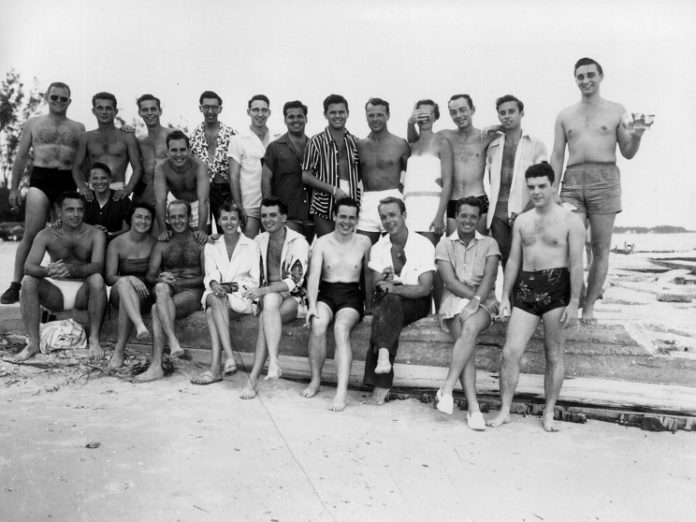
University of South Florida Tampa Library
All Quiet on the Waterfront
When Izzy Schuster arrived on the north end of Johns Pass in 1934, the area had few amenities. A fish camp occupied nearby land and a few wooden cottages sat along the waterfront near the original 1927 bridge. A small barn-like structure offered a place where the bridgetender could pass time during the slow afternoons along the Pass.
Schuster soon set up a store, lunch counter, and gas station. The Little House restaurant opened in 1937, and a couple of shops and bars appeared before America entered World War II in December 1941. Aside from fishing fleets, this coastal oasis remained a quiet, largely undeveloped area.

Heritage Village
Business increased after the war. In December 1946, Schuster moved into his new $50,000 building – quite a structure at the time – that had apartments and a market. In January 1947, the first post office between Pass-a-Grille and Indian Rocks Beach opened at Johns Pass. When areas north of 140th Avenue incorporated into Madeira Beach in May 1947, much of the sandy acreage around Johns Pass remained a sparsely settled area, where the tall Australian pines along the shoreline outnumbered the people strolling upon the beach.

Pinellas Memory
A Quiet Place to Gather
This remote area began to attract a new crowd by the early 1950s. Mostly twenty- and thirty-somethings, these young adults congregated along the wooden groins near Johns Pass. They purchased beers and sodas from Jack’s Place, a local watering hole that gladly accepted their patronage.
The off-the-beaten-path beaches of southern Madeira offered a quiet and discrete place to meet. A location to share hugs, stories, and friendships, this shoreline became the preferred destination to have a few drinks, watch sunsets, and escape from the unwelcoming and often-intolerant world that they would return to after leaving Madeira Beach. As the rising tides washed their footprints from the sand, they put away an identity that the larger world almost unanimously would fail to accept.

University of South Florida Tampa Library
In addition to their time at Jack’s Place and along Johns Pass almost seven decades ago, these people had few other Pinellas destinations where they could safely gather. Some traveled across the Gandy Bridge to enjoy drinks and dancing at Tampa bars such as the Brass Rail, the Knotty Pine, and Jimmie White’s Tavern.
At those Tampa locations, all of them knew the routine. Some places required a code word to enter. All of these establishments kept somebody near the door, ready to send a signal if any police approached the building.
What were these people doing that had them so fearful of a visit from law enforcement? After all, they simply were being themselves. Indeed, that is why they often felt a sense of fear.

University of South Florida Tampa Library
Creating Safe Places Amidst Intolerance
During the 1950s, much hate washed upon the shores of the Sunshine State. Florida remained a segregated state, clutching its Deep South roots. After those trying to end racial segregation launched the Tallahassee bus boycott in May 1956, legislators went into special session and passed a bill to create the Florida Legislative Investigation Committee.
Commonly known as the Johns Committee for its chair – former acting governor and state Senator Charley E. Johns – this body sought to connect civil rights groups to a supposed communist conspiracy. However, for most of its history from 1956 though its abolition in 1965, the Johns Committee focused its wrath on another group: Gay, lesbian, bisexual, and transgendered Floridians.

Florida Memory
The Johns Committee targeted many LGBTQ teachers and public employees, along with an unknown number of private citizens. In 1964, legislators on the Johns Committee even used taxpayer dollars to fund the publication of “Homosexuality and Citizenship in Florida,” an example of state-sponsored homophobia.
When a signal was sent at those bars, dancing partners quickly paired up with someone of the opposite gender. Police raids of so-called “gay bars” were commonplace in Florida long before the Stonewall uprising of June 1969 in New York City brought national attention to the challenges faced by the gay community.
Those gatherings at Johns Pass provided a refuge from this hate. Even after they came to an end, they offered memories of a beach destination where friends had enjoyed safety, camaraderie, and tranquility during a turbulent time.

University of South Florida Tampa Library
Treasured Tomes and Times on the Beach
St. Petersburg native Edie Daly returned to Pinellas in 1981, 16 years after the Johns Committee’s demise. Aside from some bars such as Gulfport’s Cheshire Cat (that later became Sharp A’s and Pepperz Cabaret), few gathering places for the south Pinellas LGBTQ community existed at that time. As Daly recalled in a May 19, 2016 Gabber article, she wanted to create a quiet and safe place for women to gather.
During the early 1980s, Daly was involved in the opening of a bookstore a little north of Johns Pass known as The Well of Happiness. Located along Gulf Boulevard, the store’s name paid honor to the popular lesbian novel penned by British author Radclyffe Hall in 1928, The Well of Loneliness. It was near The Other End, a lesbian bar.
At The Well of Happiness, Daly and other women used a black book located behind the counter of the bookstore as a way to build a safe social network years before the internet. Women who quietly shared their names and addresses learned about groups such as the St. Petersburg Salon, co-founded by Daly nearly 40 years ago, on October 1, 1982.
The Salon offered a safe place for feminists and women who identified as bisexual or lesbian to gather. After meeting in St. Petersburg, the group Daly remembered as a “radical feminist collective” moved its meetings to Madeira Beach. The Salon briefly met at Madeira’s former city hall, before locating to other venues.

University of South Florida Tampa Library
Jack’s Place, The Well of Happiness bookstore, and The Other End lounge no longer exist. Tall condos occupy the shoreline near where members of the LGBTQ community gathered away from the crowds decades ago. Jack’s Place disappeared. The Madeira Bay Resort and Marina soars above the grounds where the bookstore and lounge once operated.
Even if the names of those who gathered at Johns Pass long ago have largely been forgotten, these locations that offered them a coastal oasis during a different era are places certainly worth remembering.
Team Gabber brought back the print version of the newspaper, and we’ve redesigned our website to make it easier for you to get the news. We’re not out of the woods yet, and every little bit helps pay our reporters, printer, and other expenses. Support local news and families — donate now to keep The Gabber Newspaper serving the community it loves!








